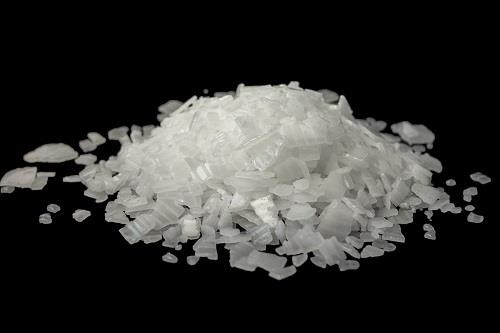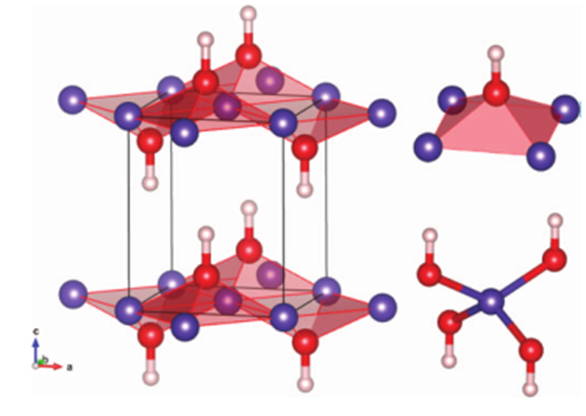Introduction of Potassium hydroxide
General description
Potassium hydroxide is an inorganic compound which is denoted by the chemical formula KOH. Potassium hydroxide is also known as caustic potash, lye, and potash lye. This alkali metal hydroxide is a very powerful base. In its aqueous form, its appearance is that of a clear solution. It is a common inorganic base with chemical formula of KOH and molecular weight of 56.1. It is white powder or flake solid at room temperature. The property is similar to that of sodium hydroxide, with strong alkalinity and corrosivity. The pH of 0.1 mol / L solution is 13.5. It is very easy to absorb moisture in the air and deliquesce, and absorb carbon dioxide to form potassium carbonate.
Chemical and Physical property
Potassium hydroxide is strongly alkaline and corrosive. Its properties are similar to sodium hydroxide and can cause burns. It can absorb water and dissolve in the air, absorb carbon dioxide and gradually turn into potassium carbonate. The pH of 0.1 mol / L solution is 13.5. [1] Potassium hydroxide has the universality of alkali, which has the following properties: 1 The color reaction can make litmus test solution turn blue and phenolphthalein test solution turn red. 2. React with acid, such as hydrochloric acid, sulfuric acid, nitric acid and hydrogen sulfide. White orthorhombic crystal, industrial products are white or light gray block or rod. It is easily soluble in water, and gives off a large amount of dissolution heat when dissolving. It is soluble in ethanol and slightly soluble in ether. It is easy to deliquescence and has strong water absorption.
Application
1.Used for electroplating, engraving, lithography, etc. Used as raw materials for potassium salt production, such as potassium permanganate, potassium carbonate, etc. It is used in the production of testosterone, progesterone and progesterone in medicine. In light industry, it is used to produce potassium soap, alkaline battery and cosmetics (such as cold cream, snow cream and shampoo). In the dye industry, it is used to produce vat dyes, such as vat blue RSN, etc. It is used as an absorbent for analytical reagent, saponification reagent, carbon dioxide and water. In the textile industry, it is used for printing and dyeing, bleaching and mercerization, and is widely used as the main raw material for the manufacture of man-made fibers and polyester fibers, as well as for the manufacture of melamine dyes. It is also used in metallurgical heating agent and leather degreasing. The major problem in rice straw pulping is silica. The present research is focused on the separation of silica from the black liquor of rice straw pulping by potassium hydroxide (KOH) and pulp evaluation. Optimum KOH pulping conditions of rice straw were alkali charge 12% as NaOH, cooking temperature 150℃ for 2 h and material to liquor ratio, 1:6. At this condition pulp yield was 42.4% with kappa number 10.3. KOH pulp bleached to 85% brightness by 1bleaching sequences with ClO2 consumption of 25 kg/ton of pulp. Silica and lignin were separated from the black liquor of KOH pulping. The amount of recovered silica, lignin and hemicelluloses were 10.4%, 8.4% and 13.0%. The papermaking properties of KOH pulp from rice straw were slightly better than those of corresponding NaOH pulp[1].
2.Microscopic potassium hydroxide preparation: A likelihood ratio of 2.86 with regard to finding fungal infection using KOH preparation.1 This represents a clinically useful value in the context of a common diagnosis. Moreover, the set-up required for this diagnostic tool is modest (KOH and a microscope), and the procedure can be performed quickly at the point of care. Culture is the criterion standard test used to determine the presence of a fungal infection. Given that culture has a likelihood ratio that is only moderately superior (3.28) to KOH preparation, is expensive, and takes 6 weeks to yield a result, teaching microscopic KOH preparation appears to be reasonable during residency. However, a negative KOH preparation result should still prompt a culture[2].
Synthesis
In the original design,the liquid level of the anolyte tank in the electrolysis process of the potassium hydroxide production unit is controlled by the regulating valve installed at the outlet of the anolyte pump,but the anolyte tank level and the backup pump for anolyte pump do not have an interlocking relationship,so when the anolyte pump fails,the backup pump cannot be started in time, and there is a risk that the potassium hydroxide production unit will shut down due to chlorine leakage[3].
Figure 1 Electrolytic process flow
The potassium hydroxide production unit mainly sends the high-purity brine obtained by refining the raw salt through the primary brine and secondary brine processes to the electrolysis process, the potassium hydroxide with a mass fraction of 32% generated by electrolysis is sent to the evaporation process, and the wet chlorine and wet hydrogen are sent to the chlorine treatment process and hydrogen treatment process respectively. As shown in Figure 1, the electrolysis process is mainly to send the secondary refined brine with pH 2 to the anode chamber of the electrolytic cell for electrolysis, the generated light brine flows into the anode liquid tank, and then pumped to the dechlorination tower through the anode liquid, and the generated chlorine is sent to the chlorine treatment process; The cathode liquid generated in the cathode chamber of the electrolytic cell flows into the cathode liquid tank, and then one part is pumped by the cathode liquid to the evaporation solid alkali process. After cooling, the other part is recycled back to the electrolytic cell by adding pure water, and the hydrogen generated in the cathode chamber is sent to the hydrogen treatment process.
Storage and Safety
Soluble in about 0.6 parts of hot water, 0.9 parts of cold water, 3 parts of ethanol and 2.5 parts of glycerol, slightly soluble in ether. When dissolved in water, alcohol or treated with acid, a large amount of heat is generated. Moderate toxicity, LD50 (rat, oral) 1230 mg / kg. It can burn tissue, dissolve protein and form alkaline denatured protein. When the solution or dust splashes on the skin, especially the mucous membrane, soft scabs can be produced. The higher the solution concentration, the higher the temperature and the stronger the effect. Splashing into the eye can not only damage the cornea, but also damage the deep tissue of the eye. The maximum allowable concentration is 0.5 mg / m3. Avoid touching the skin and eyes during work. In case of accidental contact, wash the damaged parts with running water, and then wet compress 5% acetic acid, tartaric acid, hydrochloric acid or citric acid solution; If splashed into the eyes, wash carefully and slowly with running water or normal saline for 10 ~ 30 minutes, and then point in 2% novocaine or 0.5% dicaine solution. During operation, wear work clothes made of solid cloth, rubber gloves, sleeves, aprons, rubber shoes and other labor protection articles, and apply neutral and hydrophobic ointment on hands.
Precautions for transportation: during railway transportation, the steel drum packaging can be transported by gondola. The package shall be complete and the loading shall be stable at the time of shipment. During transportation, ensure that the container does not leak, collapse, fall or damage. It is strictly prohibited to mix with inflammables or combustibles, acids, edible chemicals, etc. During transportation, transport vehicles shall be equipped with leakage emergency treatment equipment; 2. Storage precautions: store in a cool, dry and well ventilated warehouse. Keep away from kindling and heat sources. The humidity in the warehouse should not be greater than 85%. The package must be sealed and free from moisture. It shall be stored separately from inflammable (combustible) substances and acids, and mixed storage shall be avoided. The storage area shall be equipped with appropriate materials to contain leakage; 3. Packing method: the solid can be put into a 0.5mm thick steel drum and sealed tightly, with a net weight of no more than 100kg per barrel; Full opening or medium opening steel drum outside plastic bag or two-layer kraft paper bag; Threaded glass bottles, iron capped pressure glass bottles, plastic bottles or ordinary wooden cases outside metal barrels (cans); Threaded glass bottles, plastic bottles or tinned sheet steel barrels (cans) are covered with bottom plate lattice boxes, fiberboard boxes or plywood boxes; Tinned steel sheet barrel (can), metal barrel (can), plastic bottle or metal hose outer corrugated box.
Reference
1.Jahan M. S., Haris F. & Rahman M. M. et al., "Potassium hydroxide pulping of rice straw in biorefinery initiatives," Bioresource Technology, Vol.219(2016), pp.445-450.
2.Ponka D. & Baddar F., "Microscopic potassium hydroxide preparation," Canadian family physician, Vol.60, No.1(2014), p.57.
3.Yang Delin, Yang Zhengfa, Zhong Shouping: improvement of anode liquid pump control mode of potassium hydroxide plant, chemical fertilizer industry, 2019, No. 01, pp. 53-54.
You may like
Related articles And Qustion
Lastest Price from Potassium hydroxide manufacturers

US $1.00/kg2025-04-21
- CAS:
- 1310-58-3
- Min. Order:
- 1kg
- Purity:
- 99%
- Supply Ability:
- 1000mt/year

US $22.50/kg2025-04-11
- CAS:
- 1310-58-3
- Min. Order:
- 26000kg
- Purity:
- 98%
- Supply Ability:
- 200tons per month




